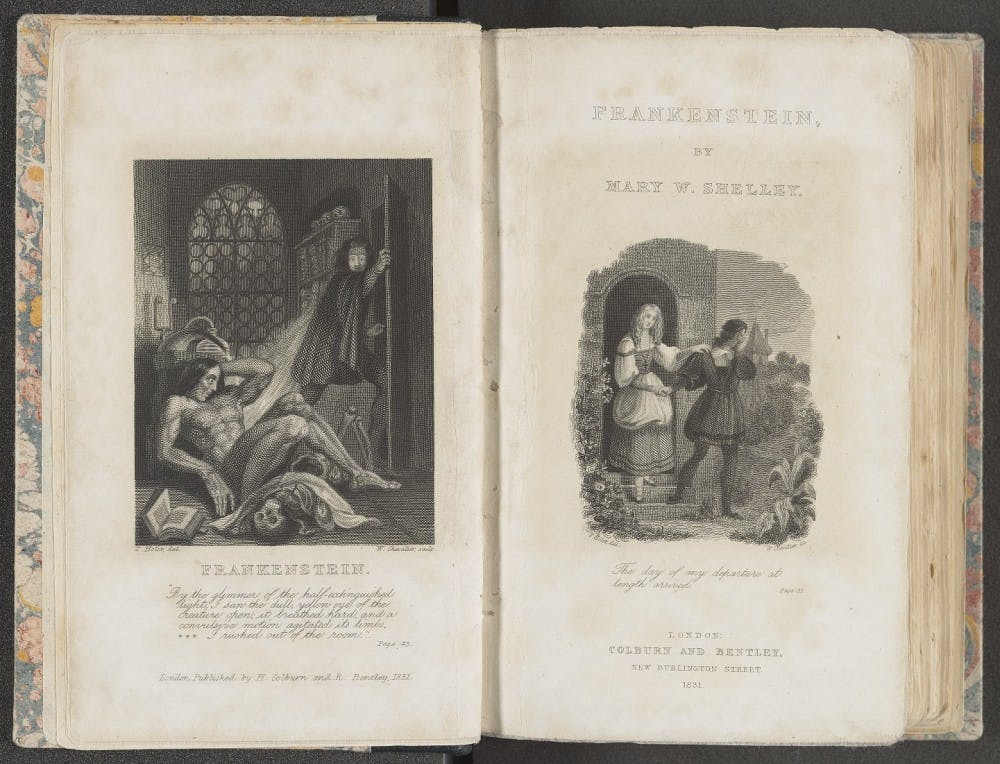The Alexander Grass Humanities Institute at the Krieger School of Arts and Sciences organized several events to mark the 200-year anniversary of the publication of Mary Shelley’s Frankenstein.
The commemorative events include an ongoing exhibit, Frankenstein: 200 Years in Print, which is open through Nov. 30 at the George Peabody Library. This exhibit features early and illustrated editions of Mary Shelley’s famous novel, along with theater and film tie-ins and 20th century homages to the monster’s tale.
Other events included screenings of two Frankenstein films at the Parkway Theatre, a panel discussion, and a question and answer segment featuring faculty members on Oct. 31.
Acknowledging the exciting and interesting nature of the story, Gabrielle Dean, organizer of the exhibit, explained why she thinks Frankenstein has remained relevant in print for generations.
“When a book is reprinted and translated and adapted so frequently it gives many different people, over time, the opportunity to read it,” she said. Dean explained that the story has remained relevant in today’s generation because of research in artificial intelligence and robotics combining human aspects in scientific creations.
“Since the book’s publication 200 years ago, one of the questions that many different generations have had to grapple with is the relationship between biological humanity and what we can make through science,” she said.
Shifting the focus away from the scientific aspect of the novel, Dean spoke about the compelling nature of encountering a character who is neither good nor evil, but somewhere in-between.
She stated that as science has evolved, Frankenstein has provided a way to reflect on different issues and raises ethical questions.
“Is the scientist wrong for playing God in this way? Is the monster a victim of his creator’s ambition? Is he destructive? Is he quintessentially human, in that he contains all these different urges?” Dean said.
Dean said that although the exhibit does not include the very first edition of Mary Shelley’s novel from 1818, the University’s Special Collections has quite a few early editions of the novel. The exhibit houses one of the first critical reviews of the publication. Written in 1818, it is the oldest item in the collection.
Dean described another historical item in the collection — a broadside, a small poster, advertising a theatrical adaptation of Frankenstein. She noted that the novel was already being adapted for the stage five years after it was published.
“When we think of Frankenstein now, we have a mash-up in our minds of some of the film adaptations and the novel and all the different kinds of homage to Frankenstein that exist,” she said.
The exhibit also houses the third edition of the novel, published in 1831, which is a significant edition because of the changes Mary Shelley made from 1818 version. These changes came partly as a response to changing perceptions and ideas about the novel.
“Her popularity as an author made it possible for her publisher to invest more money in publishing,” Dean said. “He gave it an illustration. So it’s the first illustrated edition.”
Dean also spoke about how the illustrations of the story have evolved over the years. She compared famous illustrator Landward’s human-like illustrations from a 1930s edition with a classic illustrated comic book version of Frankenstein.
“Our 21st century view of the monster that’s been shaped by all these different film and television adaptions, that monster is very monster-y,” she said. “The original illustration suggests that the monster is very human.”
Dean also mentioned that she had not realized that Mary Shelley’s name did not appear on the title page of the first edition of the book. Dean thought the exhibit gave her insight into the stigma attached to women demonstrating any public act of authority at the time.
She believes that the rare artifacts and editions on display make for an interesting exhibit.
“It’s always intriguing to see how books from a couple of hundred years ago looked, and even things that were published in the 1970s can look strange to us now,” Dean said.
Since the exhibit has only been open for a week, Dean concluded by expressing her hope that more people will attend over the course of the month.
“I’m hoping that interest from the film screenings and panel discussion, maybe students who participated in the writing contest, will extend to seeing the exhibit as well,” she said.





